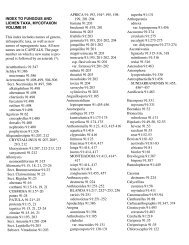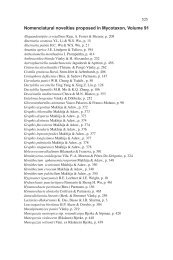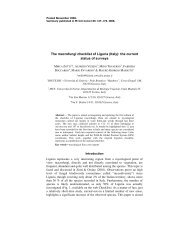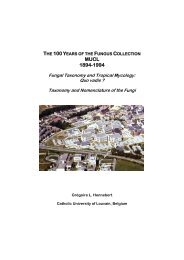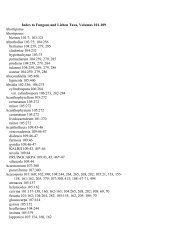download full review [pdf] - Mycotaxon
download full review [pdf] - Mycotaxon
download full review [pdf] - Mycotaxon
You also want an ePaper? Increase the reach of your titles
YUMPU automatically turns print PDFs into web optimized ePapers that Google loves.
522 ... Hawksworth, Editor<br />
or photographs of microscopic features. Even though this is in Estonian, it will<br />
be a boon to all wishing to name polypores in the region. The translation was<br />
made possible by a grant from the Estonian Environmental Investment Centre,<br />
and Erast writes that about a third of the print run was being distributed free<br />
of charge to staff and students in Estonian universities, forest pathologists,<br />
nature conservationists, and amateur mycologists. Erast further comments that<br />
“thanks to the possibility to have such a translation, I spared some years of<br />
my life: otherwise I had to compile [a] similar book (as I had promised many<br />
years), surely not better that Tuomo’s one”. What better recommendation could<br />
there be than that?!<br />
Pilzkompendium. Band 2. By Erhard Ludwig. 2007. Fungicon-Verlag, Saalower<br />
Straße 42, D-12307 Berlin, Germany; . Pp. 723 (text volume)<br />
+ plates 205 (plates volume). ISBN 978-3-940316-01-1 (text); 978-3-940316-00-4<br />
(plates). Price 72 € (text) + 138 € (plates).<br />
This is the second part of a magnum opus aiming to illustrate and describe all<br />
the European agarics (plus some other macrofungi) in twelve volumes. This<br />
would be a major challenge for a well-funded consortium of mycologists, but<br />
Erhard Ludwig is writing, painting, and publishing the whole series himself.<br />
To tackle such a project on one’s own is a remarkable achievement. To tackle it<br />
success<strong>full</strong>y is simply astonishing.<br />
Each part consists of a volume of text together with a large-format (34 x<br />
24 cm) volume of coloured plates. The first part, published in 2001 (and not<br />
received for <strong>review</strong> by <strong>Mycotaxon</strong>) dealt with 89 small genera of agarics and<br />
has proved extremely useful as a convenient first source of information on these<br />
often neglected species. An unfamiliar agaric found in England in 2008 was, for<br />
example, quickly tracked down to the genus Callistosporium (not previously<br />
known in Britain) thanks to Pilzkompendium.<br />
This second part is subtitled ‘The larger genera of Agaricales with coloured<br />
spores (except Cortinariaceae)’ and as such deals with Agaricus (plus<br />
Allopsalliota), Conocybe, Coprinus (inclusive of Coprinellus, Coprinopsis,<br />
and Parasola), Entoloma, Lacrymaria, Pholiotina, Pluteus, and Psathyrella.<br />
Altogether, 547 species are illustrated and described.<br />
The text is in German, but each taxon entry starts with a brief English<br />
summary. Separate paragraphs then note macro- and microscopic characters,<br />
similar species, literature references, and details of the collections pictured.<br />
Line drawings illustrate microscopic details. An abbreviated key (leading one<br />
to groups of taxa, rather than individual species) is provided for each genus.<br />
The plates are impressive and beauti<strong>full</strong>y produced. Watercolour paintings<br />
of fungi can often be amateurish in the worst sense – flat, over-stylized, or oddly<br />
coloured. But Erhard Ludwig is an excellent illustrator and his artwork is lifelike


![download full review [pdf] - Mycotaxon](https://img.yumpu.com/5381692/14/500x640/download-full-review-pdf-mycotaxon.jpg)
